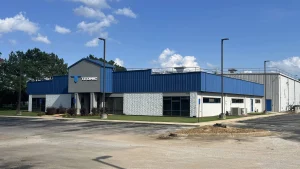HUNTSVILLE – Huntsville sweet home.
Not only did Titomic open a facility in Huntsville, company decided to make the Rocket City its global headquarters.
A manufacturer of advanced metal additive manufacturing systems, Titomic cited the proximity to its U.S. customers in the aerospace, defense, and industrial sectors.

“Our customers include aerospace and defense suppliers such as Boeing and Airbus,” said CEO Jim Simpson. “Establishing a facility in the United States improves our ability to work directly with customers and support their industrial and operational requirements.
“Selecting Huntsville reflects the region’s strategic importance to the U.S. manufacturing and defense sectors.”
Titomic’s patented cold spray technology, Titomic Kinetic Fusion, uses high-pressure gas to accelerate metal powders to supersonic speeds, bonding them without melting, the company said. This solid-state process enables the manufacture and restoration of structural components using materials that are often difficult or inefficient to work with using conventional methods.
Because it does not rely on heat, it avoids thermal distortion and enables bonding between dissimilar metals.
The Huntsville facility is equipped to produce or repair metal parts up to 10 feet in length at deposition rates exceeding 13 pounds per hour, the company said. It is intended to support U.S. efforts to secure sovereign manufacturing capability, reduce reliance on imported parts, and enable production at or near the point of need. These capabilities align with current Buy America programs and broader efforts to improve supply chain resilience for critical industries.
The facility is along Alabama 20/I-565, in a former Pratt & Whitney building next to Cowin Equipment and across the highway from Redstone Harley-Davidson.
It includes production, demonstration, and R&D capabilities, and complements the company’s operations in Australia and the Netherlands.
Titomic said its patented cold spray technology, Titomic Kinetic Fusion, represents a shift from traditional subtractive methods, which rely on cutting material from billets.
By depositing metal only where required, the process supports near-net-shape part builds with significantly reduced waste. This is particularly relevant in the use of high-cost materials such as titanium, where conventional machining can generate high volumes of scrap.
The technology also enables repair and coating of worn surfaces in situations where conventional welding or heat-based techniques are unsuitable.
Don’t miss out! Subscribe to our email newsletter to have all our smart stories delivered to your inbox.


